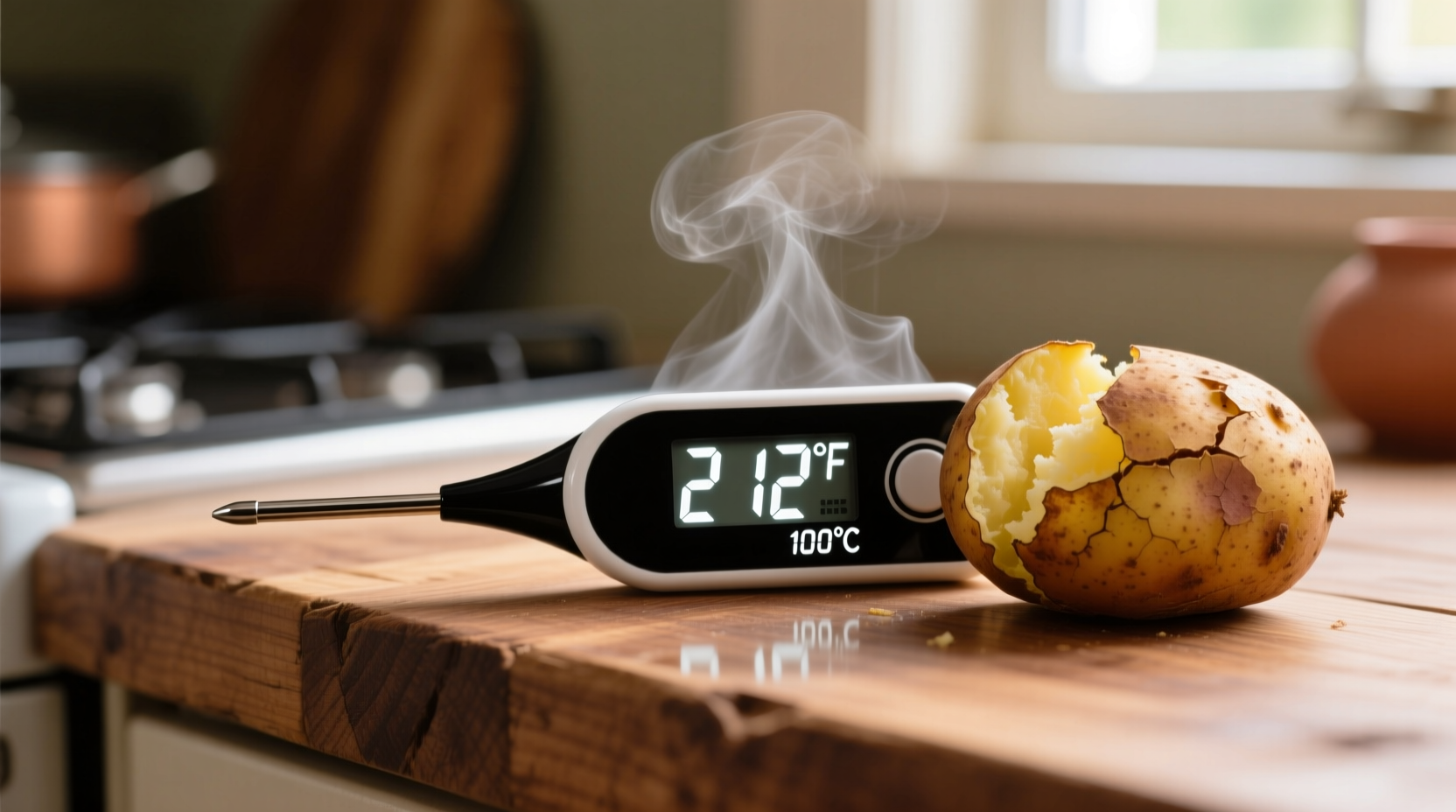Ever cut into a baked potato only to find a dense, undercooked center? Or worse, an overcooked, collapsing mess? Temperature control is the secret weapon professional chefs use to guarantee perfect baked potatoes every time. As someone who's tested hundreds of potatoes across various cooking methods, I can tell you that hitting that precise 205-210°F sweet spot transforms an ordinary side dish into something extraordinary.
The Science Behind Perfect Potato Texture
Potato perfection hinges on starch gelatinization—the process where starch granules absorb water and swell. This critical transformation begins around 190°F (88°C) but reaches optimal texture at 205-210°F (96-99°C). Below this range, your potato remains dense and undercooked. Exceeding 212°F (100°C) causes excessive moisture loss, leading to dry, crumbly interiors.
According to research from the USDA Agricultural Research Service, the ideal internal temperature ensures complete starch conversion while preserving just enough moisture for that signature fluffy-yet-structured texture. This isn't just culinary preference—it's food science in action.

How to Measure Temperature Like a Pro
Don't guess—verify. Here's how to get accurate readings:
- Use the right tool: Instant-read digital thermometers (like Thermapen) provide the most accurate readings in seconds
- Insert correctly: Place the probe into the thickest part of the potato, avoiding the center where heat concentrates
- Check multiple spots: Large potatoes may have temperature variations—test 2-3 locations
- Wait it out: Remove potatoes from heat at 200°F—residual cooking will take them to 205-210°F during resting
Temperature Guide for Different Cooking Methods
| Cooking Method | Oven Temp Setting | Target Internal Temp | Approx. Cooking Time | Best For |
|---|---|---|---|---|
| Conventional Oven | 400-425°F (204-218°C) | 205-210°F (96-99°C) | 55-75 minutes | Fluffy texture, crispy skin |
| Air Fryer | 390°F (199°C) | 200-205°F (93-96°C) | 35-45 minutes | Quick cooking, extra-crispy skin |
| Grill/BBQ | Indirect heat 375-400°F (190-204°C) | 205-210°F (96-99°C) | 45-60 minutes | Smoky flavor, outdoor cooking |
| Convection Oven | 375°F (190°C) | 205-210°F (96-99°C) | 45-55 minutes | Faster cooking, even browning |
Context Matters: When Standard Temperatures Don't Apply
While 205-210°F works for most russet potatoes, certain situations require adjustments:
- High altitude cooking: Above 3,000 feet, water boils at lower temperatures, extending cooking time by 25-30%. Check potatoes 15 minutes later than usual.
- Different potato varieties: Waxy potatoes (like Yukon Gold) reach optimal texture at slightly lower temperatures (200-205°F) due to lower starch content.
- Stuffed potatoes: When adding fillings before baking, increase target temperature to 212°F (100°C) to ensure fillings cook through.
- Leftover reheating: For safe consumption, reheat to 165°F (74°C) minimum per FDA Food Code guidelines.
Temperature Troubleshooting Guide
Encountering issues? Match your problem to these temperature solutions:
Undercooked Center (Below 195°F/90°C)
Solution: Return to oven for 10-15 minute increments, checking temperature each time. Prick skin with fork before returning to help heat penetrate.
Dry, Crumbly Texture (Above 212°F/100°C)
Solution: Next time, reduce oven temperature by 25°F and wrap potatoes in parchment before baking to retain moisture.
Inconsistent Cooking
Solution: Rotate baking sheet halfway through cooking. For large batches, arrange potatoes in single layer with space between each.
Pro Tips for Temperature-Perfect Potatoes
- Room temperature start: Let potatoes sit at room temperature for 30 minutes before baking for more even heating
- The foil debate: Avoid foil wrapping—it steams rather than bakes. For crispier skin, rub with oil and salt before baking
- Resting is crucial: Allow 5-10 minutes resting time after baking—this lets residual heat complete cooking without overdoing it
- Size matters: Adjust cooking time by 10-15 minutes per additional inch in diameter
Food Safety Temperature Guidelines
While texture perfection happens at 205-210°F, food safety requires potatoes to reach at least 165°F (74°C) to eliminate potential pathogens. The Centers for Disease Control recommends storing cooked potatoes at 40°F (4°C) or below within two hours of cooking. When reheating, always bring to 165°F (74°C) minimum for safety.
Evolution of Baked Potato Knowledge
Understanding baked potato temperature has evolved significantly:
- Pre-1950s: Home cooks relied on visual cues and timing alone, with inconsistent results
- 1950-1980s: Introduction of meat thermometers led to first temperature guidelines (often inaccurate for potatoes)
- 1990s: Food science research identified starch gelatinization temperatures
- 2000s: Precision cooking thermometers became affordable for home use
- Today: Digital instant-read thermometers provide restaurant-quality precision in home kitchens











 浙公网安备
33010002000092号
浙公网安备
33010002000092号 浙B2-20120091-4
浙B2-20120091-4